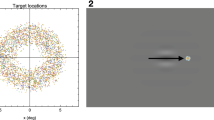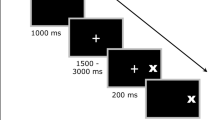Abstract.
Several studies have reported that patients with schizophrenia and their relatives perform poorly on antisaccade tasks and have suggested that this deficit represents saccadic disinhibition. If this proposition is correct, then varying task parameters that specifically increase the difficulty with which unwanted saccades can be inhibited should exacerbate deficits. Forty-two schizophrenia patients, 42 of their first-degree biological relatives, 21 psychotic affective disorder patients, and 38 nonpsychiatric comparison subjects were given fixation and antisaccade tasks. The introduction of distracters and the presence of visible fixation stimuli were parameters used to vary the difficulty in suppressing unwanted saccades (inhibitory load). It is known that the presence of a fixation stimulus at the time when a saccade must be inhibited results in fewer reflexive errors on antisaccade tasks. Performance on fixation tasks without (low load) vs with distracters (high load) and antisaccade tasks that had fixation stimuli still visible (low load) vs already extinguished (high load) at the time when the reflexive saccade must be inhibited was compared. The schizophrenia patients and their first-degree biological relatives showed evidence of increased saccadic disinhibition that was most pronounced during high inhibitory load conditions. These data indicate that dysfunctional inhibitory processes, at least in the oculomotor domain, are associated with the liability to schizophrenia. Results also suggest that this genetic liability may be related to dysfunctional prefrontal cortical areas that provide top-down inhibitory control over reflexive saccade generation.
Similar content being viewed by others
Author information
Authors and Affiliations
Additional information
Electronic Publication
Rights and permissions
About this article
Cite this article
Curtis, C., Calkins, M. & Iacono, W. Saccadic disinhibition in schizophrenia patients and their first-degree biological relatives. Exp Brain Res 137, 228–236 (2001). https://doi.org/10.1007/s002210000635
Received:
Accepted:
Issue Date:
DOI: https://doi.org/10.1007/s002210000635




